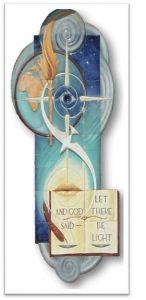Mural

Set off-centre to the left into the hall wall, the plaque was designed and built by the late Miss Sylvia Baxter. It took her months of hard work, with sometimes a stretch of 48 hours’ work on moulding, colouring and baking the clay. It was fired in forty six pieces of ceramic clay, measuring 4 meters by 2 metres and a mass is over a ton. Metallic oxides were used to give it the beautiful colouring.
The Plaque is a symbolic representation of the Holy Trinity. The lips represent the word of God, “let there be light” as shown on the open page of the book. The eye is the all-seeing eye of God, stressed further by the four cardinal points of the compass, with the eye as the hub. The bird, a stylised dove, represents the Spirit. The scale pans and feather are there as a reminder that our conscience should weigh as light as a feather. The torch signifies the light of learning. The “clouds” indicate the formlessness of the earth before the Spirit of God moved upon the face of the waters. Dry land (Africa) and the waters can be distinguished; so, too, can night (stars) and day.
The plaque was unveiled by Senator A. E. Trollip, then Administrator of Natal, when the school was officially opened on the 25 September 1964.
